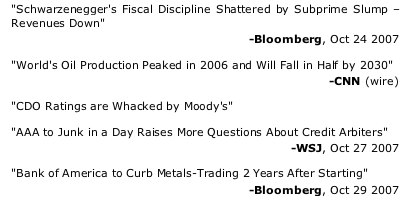 SIGNS OF THE TIMES - NOVEMBER 12, 2007 SIGNS OF THE TIMES - NOVEMBER 12, 2007
Bubbles and Train Wrecks
Bob Hoye
Institutional Advisors
Nov 14, 2007
Signs Of The Times:

In real time, credit contractions
don't always follow a straight line. However, in the fullness
of time they seem to have gone by rather quickly. Perhaps Merrill's
report of a $5 billion write down was an attempt to get out all
the bad news and then some. Regrettably, changes in price have
not only been inconvenient, but have been unrelenting and encompassing
a range of instruments. Then the estimated was reported to be
in the order of $10 billion.
Since discussed in July, our
view has been founded upon the long history of the credit cycle,
and the almost equally long record of the establishment's futile
record of defiance, as well as just plain logic. The greatest
credit bubble in financial history is bound to be followed by
the "biggest train wreck in the history of credit".
Stock Markets: Last week, we led off with the observation
that dollar depreciation was driving stock and crude oil markets
up, and we shouldn't overlook that it was also rallying the long
bond. All the favourite asset prices were being marked up.
This seems to have changed.
The bond slipped on Tuesday, which extended steepening (bonds
to bills) to a warning level. Then, yesterday most of the screen
turned red, as stocks, bonds, metals, energies, and grains headed
south - perhaps for the winter. Last Thursday's conclusion was
"today, the next crisis has started."
Also noted lately has been
that the stock market was technically weak, as participants were
concentrating on a decreasing number of issues that were soaring,
and with today's plunge in RIMM this seems to be ending.
To be serious, there has been
a distinctive change in the market place and it seems unrelated
to policy utterances, multiples, or next year's earning - just
plain forces in the credit markets. The resumption of the crash
in the subprime "A" bond beginning in mid-October afflicted
traditional corporate spreads last week, which hit the general
stock market this week.
And even the plunging dollar
doesn't seem to be helping - or maybe in a modest way it is?
Sector Comment: Also noted last Thursday was that late
in the day the BKX finally broke below 100, and this was extended
this week as it has slumped to 91. The worst with the August
panic was 100.33. There is support at 85 with the weekly RSI
at below 30.
This week's discouraging news
stories included one by the Financial Times that the "superfund"
to restore the banking system was stalling out. Who would have
thought that such a grand name as Master-Liquidity Enhancement
Conduit, or MLEC in its shorter form, would be deemed a looser
so soon.
With dollar depreciation, base
metal mining stocks have been holding up relatively well. However
minor support at 863 was taken out yesterday, and taking out
the August low of 668 will confirm our view that a cyclical contraction
for the sector is underway.
Considering this week's pressures
in the credit markets, this looks all the more realistic.
Credit Spreads are following the pattern outlined
in May that led to the initial panic.
Our "Global Warning"
on this went out on October 16. That is when the "BBB"
subprime bond broke down, then, the "A" failed in the
second week of October. Of importance is that the market breaker
in early summer was the plunge in the "AAA" in the
third week of July. This time, the collapse started on October
19 and again the crash in the "AAA" subprime has spread
to other recently hot asset classes.
Over in traditional corporate
bondland, spreads have been quietly widening. Junk needed to
get above 667 bps to resume the widening trend, and that was
accomplished at 684 bps last Thursday. Now it is at 703 bps,
which compares to the extreme of 721 bps reached with the initial
panic.
Our advice in early summer
was to avoid most classes of bonds and to consider that the main
use of spread products would be as indicators of a severe credit
contraction.
Miscellaneous: The Baltic Freight Rate went straight
up until it reached 11,025 on October 29. The gain from the down
dip into June amounts to an outstanding 110% - in only 4 months.
The initial correction was
to 10,539 on Monday from which it has popped to 10,674.
A few weeks ago, we thought
that a possible top for the Shanghai market (FXI) could be associated
with the potential top for the Baltic. The ChartWorks proprietary
model registered an "Upside Exhaustion" reading on
the FXI in late September. The high was 218 on October 17 from
which it backed off to 187 and the test made it to 219 at the
end of October. It is now threatening the recent low and taking
that out would lead to an intermediate correction.
This could put a lid on the
Baltic, and the expected next leg of the credit crisis seems
to be underway, and in time this could bring the shipping rate
down.

Golds: With the long corruption of the term
money, there are many ways of looking at gold. In Canadian dollars
it has been a poor performer, which has taken the zest out of
the exploration small caps. Participants in this sector have
also been damaged by the collapse of speculation in the uraniums.
This reminds of an old story
from the days of the old and notorious Vancouver Stock Exchange.
It was a very depressed market and nobody was making any money
- no tax-free capital gains, no fees, and no commissions. In
a fit of genius, one guy said that all that was needed was an
outstanding mining discovery. The other in reflecting the notion
that someone was always running things said "Yeah, but 'they'
have been holding back on those lately".
Works for us, but in the meantime
gold is getting overbought, as the dollar index is approaching
what could be enough of a low to prompt an intermediate rally.
However, the extension of the
credit crisis will substantially increase the investment demand
for the unique liquidity of gold and this will continue to assist
the uptrend in the real price. Our gold/commodities index established
what appeared to be a cyclical low at 143 in May, when it turned
up with the advent of the initial liquidity crisis. This advanced
to 197 on August 16, which was one of the worst days of the panic.
With the "rescue",
our index slipped to 175 in late September and has recovered
to 196. Obviously rising through 197 would resume the uptrend,
which eventually will be a big plus for the sector. In the meantime,
stability in the dollar will shake the gold bugs out of the market.
With this in mind, we will use this rally to lighten up on the
seniors for re employment in the small caps upon opportunity.
The gold/silver ratio did not
rise through 56, which would have confirmed the problems in banking.
The decline to 53.6 is very much part of the party still going
on in the trashing of the dollar, that has created an impressive
swing on the daily RSI from overbought to oversold. This could
go a little further, but this direction is not compatible with
the resumption of a grinding liquidity crisis.
The next rise in the ratio
could be a fast catch-up move.
On October 1, John Crudele
at the New York Post wrote, "The Securities and Exchange
Commission is looking into whether Goldman Sachs cheated on its
way to enormous profits - as the rest of the financial industry
was suffering a massive downturn."
Senate Hearing on Stock
Exchange Practices, 1932
Senator Couzens: Did Goldman,
Sachs organize the Goldman, Sachs Trading Corporation?
Mr. Sachs: Yes, sir
Senator Couzens: And sold its
stock to the public?
Mr. Sachs: Yes, sir
Senator Couzens: At what price?
Mr. Sachs: At one hundred and
four. The stock was split two for one.
Senator Couzens: And what is
the price of the stock now?
Mr. Sachs: Approximately one
and three quarters.
***
-Bob Hoye
Institutional Advisors
email: bobhoye@institutionaladvisors.com
website: www.institutionaladvisors.com
SIGNS OF THE TIMES - NOVEMBER
12, 2007
Hoye Archives
The opinions
in this report are solely those of the author. The information
herein was obtained from various sources; however we do not guarantee
its accuracy or completeness. This research report is prepared
for general circulation and is circulated for general information
only. It does not have regard to the specific investment objectives,
financial situation and the particular needs of any specific person
who may receive this report. Investors should seek financial advice
regarding the appropriateness of investing in any securities or
investment strategies discussed or recommended in this report
and should understand that statements regarding future prospects
may not be realized.
Investors should note that income from such
securities, if any, may fluctuate and that each security's price
or value may rise or fall. Accordingly, investors may receive
back less than originally invested. Past performance is not necessarily
a guide to future performance. Neither the information nor any opinion expressed constitutes
an offer to buy or sell any securities or options or futures contracts.
Foreign currency rates of exchange may adversely affect the value,
price or income of any security or related investment mentioned
in this report. In addition, investors in securities such as ADRs,
whose values are influenced by the currency of the underlying
security, effectively assume currency risk. Moreover, from time to time, members of the Institutional Advisors team may be long or short positions discussed in our publications.
321gold Ltd

|